Chapter 4: Horses + boats = win?
We have conquered the mighty nation of Brunei. In the best traditions of history, future retellings of the war will insist that we were pretty sure Brunei had nuclear weapons, flamethrowers, and directed energy weapons. That way, it'll look way more impressive when we won!
March 1, 1849: We decide to build four brigades of our new Infantry. They will form the cornerstone of an even mightier army!
June 2, 1849: Japanese Reactionaries are unimpressed and revolt again. They are vanquished.
August 6, 1849: Since you keep bothering me about it, I take a look at Johore. They sure look like an easy --
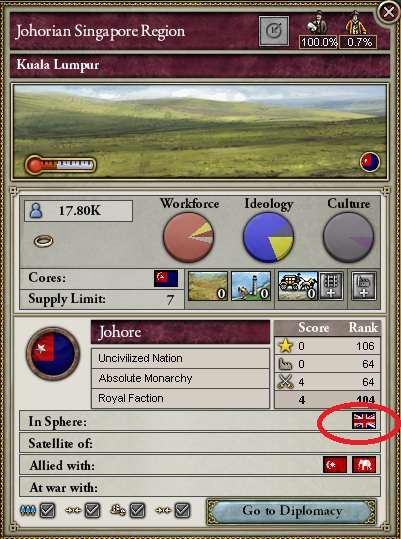
Oh.
Sphere lords/masters/potentates/whatever term you care to use (I'll use sphere master) will intervene if their spherelings are attacked most of the time. You don't even get the right to say no if you're a player. Johore went from a town bank guarded by a couple of drunks to a town bank guarded by an entire division of the US Army. We'll, uh, pass.
February 27, 1852: We are at 200 relations with the US. Whee!
November 12, 1852: Reform time again; this will give us the perfect opportunity to introduce a new and important unit to our army.
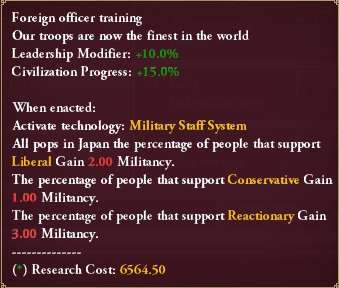
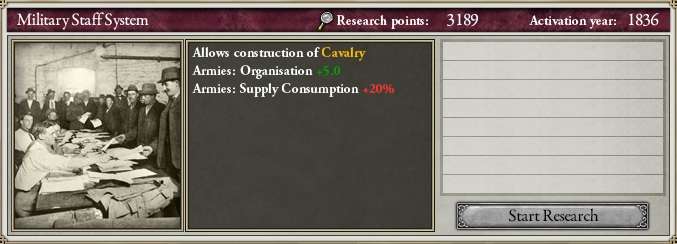
Say hello to Cavalry!
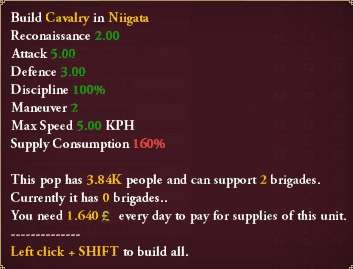
You'll notice a lot of the same stats we had for infantry, but there's a new one and an old one we'll talk about in a lot more detail now.
Reconnaissance: This has two important effects. First, it increases the rate at which you occupy provinces. Second, it counters the "dig-in" bonus enemy armies on the defensive get. (For the second purpose, your recon value is averaged among all your units).
Maneuver: Most units we've talked about have been Maneuver 1. That means it can attack one square in every direction (although, naturally, you won't attack the rank behind you, since they're your guys.) Here's an example.
*
*=*
The soldier (=) can attack the enemies directly in front of him (*) or either side. Now, let's look at a cavalry maneuver pattern.
*
***
**=**
It's got a Maneuver value of 2, so it can attack two squares in any direction. That means, if you have enough units, Cavalry can flank the enemy! (Your line has to extend past the enemy's line, either by wiping out their units or just having more to begin with.)
Now, Cavalry do have a weakness, their weak defense value. In a 1:1 battle, Infantry will tear apart Cavalry most of the time. That's the gamble with cavalry.
Therefore, there are two ways to use cavalry effectively.
1) Mix them in with your regular army. You'll want them on the ends (which is where they'll naturally go, most of the time), so generally no more than two brigades cavalry in an army (maybe four, to cover both rows) in this scenario.
2) Make independent cavalry armies. You can use them to cut off the enemy and encircle them, occupy provinces, or get somewhere in a hurry to slow down an enemy attack.
I, personally, favor #2, but if I've got the cash, I'll include a handful of cavalry brigades in an army. You won't really know what works for you until you try it out.
April 9, 1853: So, if I chuck a few guys in prison, MIL goes down? Sign me up!

May 14, 1853: Since I've got clergy coming out of my ears, I reduce their pay even further. It's important to note that this reduces educational efficiency -- a hidden stat that dictates how quickly your clergy produce literacy. To the best of my knowledge, there's no way to see that stat.
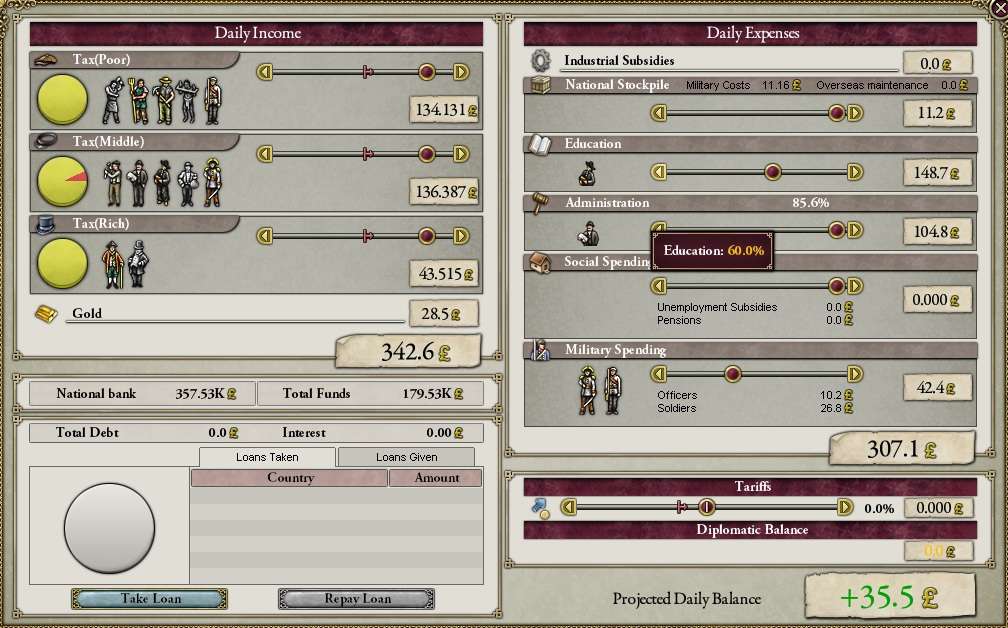
(Note: I actually cut taxes on the rich as well, to 85%, although this screenshot doesn't show it.)
October 2, 1853: Another reactionary rebellion. I don't even know why they bother.
March 27, 1854: Well, this is something.
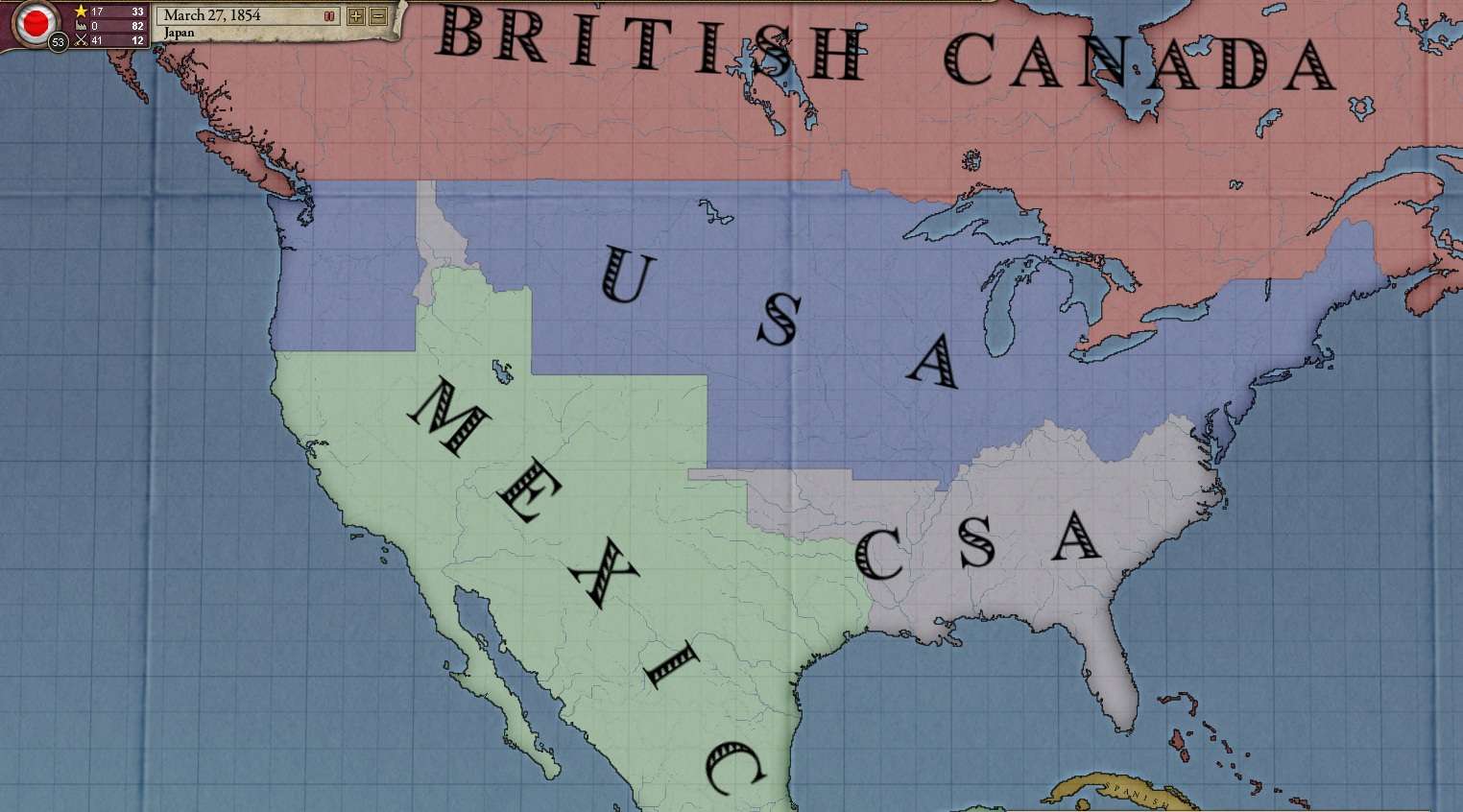
In the few games I've played of AHD, the Civil War always happens before the Mexican War; before AHD, it was almost always the reverse. Still, I don't like the Confederacy's chances, even with northern Idaho.
October 13, 1854: Time to cut down on another kind of bloat; soldier POP bloat. I cut defense spending to 20%; I can already build 51 brigades.
March 1, 1855: Anarcho Liberals in Wurttemburg. When elections matter, we'll talk about parties and ideology.
September 13, 1855: Our first Alliance offer! The Chinese want to be our friends!
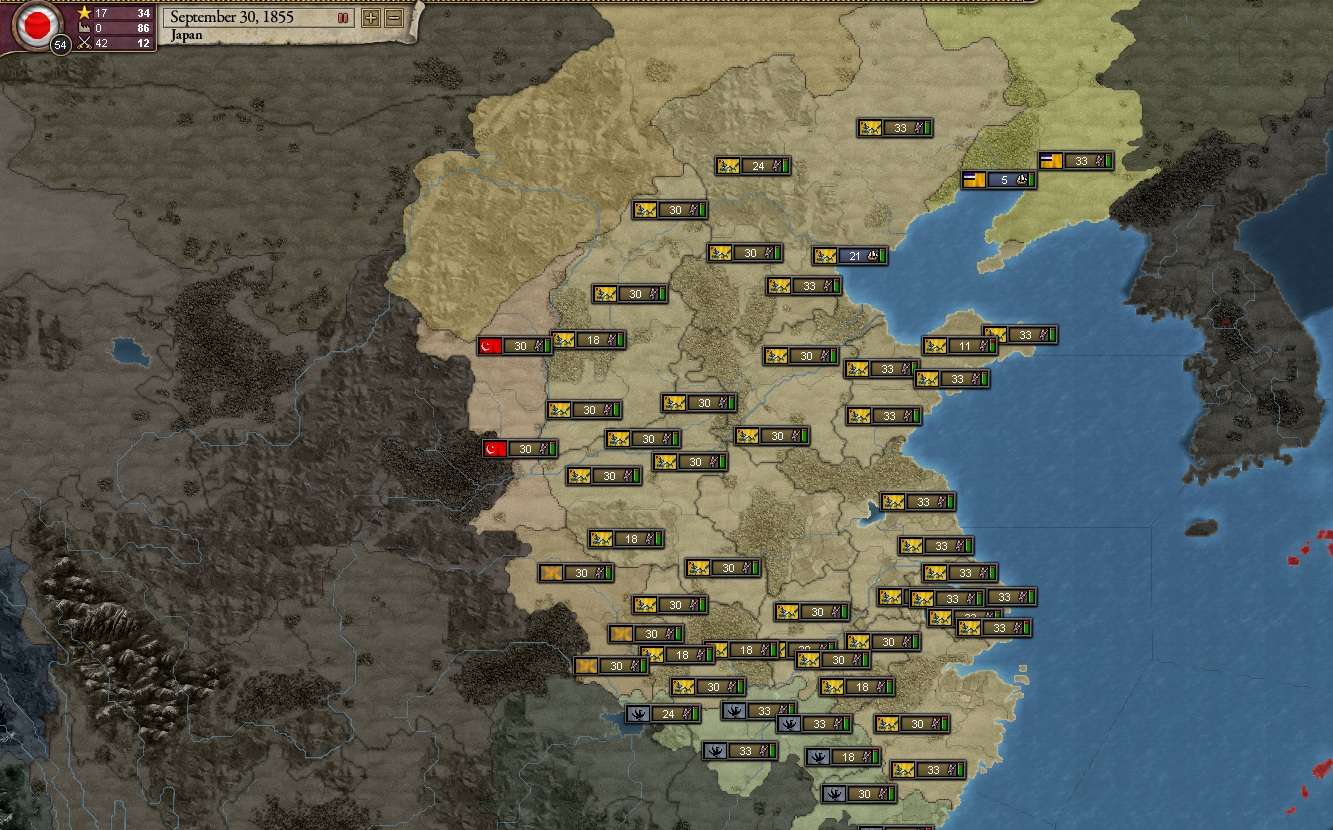 Wow.
Wow.
See why I've been harping so much on technical advancement? We will almost certainly be outnumbered when we fight the Chinese. In fact, I guarantee it. In AHD, China has so-called "substates", which are essentially puppets. This is mostly so that more than one GP can sphere China, but there's an event that unifies China at some point when you westernize.
Code:
country_event = {
id = 90901
title = "EVTNAME90900"
desc = "EVTDESC90901"
picture = "Celebration"
is_triggered_only = yes
option = {
name = "EVTOPTA90901"
civilized = yes
FROM = {
inherit = THIS
}
ai_chance = {
factor = 10
modifier = {
factor = 1000
relation = { who = FROM value = 100 }
}
}
}
option = {
name = "EVTOPTB90100"
ai_chance = {
factor = 100
}
prestige = 10
relation = {
who = FROM
value = -200
}
civilized = yes
release_vassal = THIS
leave_alliance = CHI
It isn't clear under what circumstances they'll reject it, but there's an option for that too.
Code:
country_event = {
id = 90902
title = "EVTNAME90902"
desc = "EVTDESC90902"
picture = "Celebration"
is_triggered_only = yes
option = {
name = "EVTOPTA90902"
relation = {
who = FROM
value = -200
}
civilized = yes
}
The upshot is, we will be fighting a lot of Chinese at some point, and we'd better be well prepared for it.
October 30, 1855: According to PI/PDS, Tuberculosis makes people happy. Who knew?
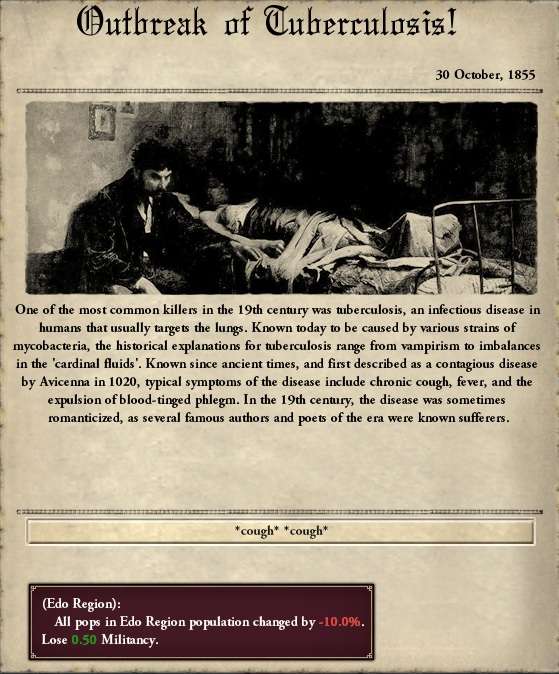
November 23, 1855: We build our first cavalry; the new army will be five brigades of infantry and two of cavalry.
July 10, 1857: Let's give the navy some love too!
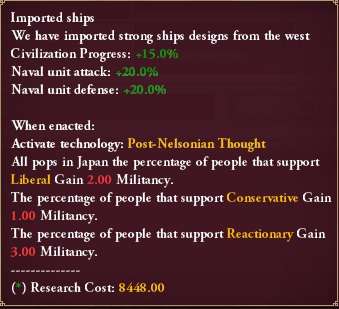

Naval bases are critical in Vicky 2, again, for two reasons. One, they are the only place you can repair ships. Two, they are what determines your colonizing distance. We build one in the Home Islands and one in Brunei.
July 28, 1857: I'm bored. Let's fight somebody! First, we think about Atjeh.
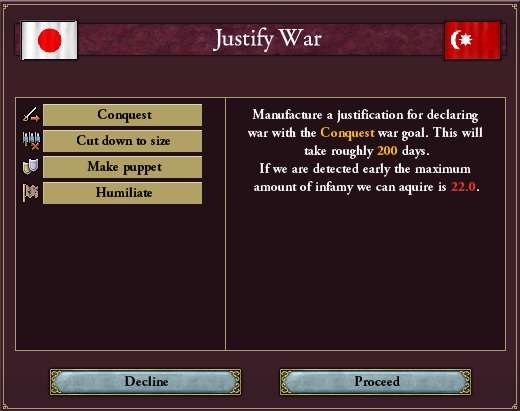
I check the diplomacy screen, and find out that the Dutch are Friendly with Atjeh. There are six relationships in AHD, from worst to best: Hostile, Opposed, Neutral, Cordial, Friendly, In Sphere. As a spheree, we have little control of this, and neither does Atjeh. However, if a GP is Friendly with any country, they can intervene in any wars in which that country has no war goals. In other words, if we attack Atjeh, the Netherlands will jump on us. That's... not good. We aren't nearly strong enough to survive a war against a GP, so we'll leave Atjeh alone.
What about Siam?

The British are Cordial. That's only one step away from Friendly. Still, AARs with no war are boring. We'll just have to hope we can take out Siam before the British get Friendly. That should be easy enough.

August 12, 1857: Busted already. 21 infamy is no fun!
September 18, 1857: We get the much needed Siamese Menace event. The faster we get the CB, the faster we can wipe them out before the British get wise.
November 17, 1857: See our mighty General who will lead our glorious army!
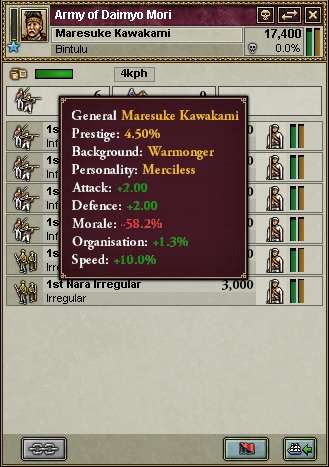
Let's go over somethings about Generals (and Admirals, for that matter). Every General in the game has one or two traits and a prestige rating. Prestige is new to AHD; you will get a bonus to morale and organization depending on how successful your General has been. You can lose prestige if you transfer them to another army.
Our General's traits are a mixed bag. He's a warmonger, which is a bonus to unit speed but a penalty to morale. He's merciless, which is a bonus +2 to attack and defense, but a penalty to morale. Morale determines how quickly you regain ORG, so essentially, our troops will fight well but take a long time to recover. He's not ideal, but he should easily be able to handle Siam, and I'm hoping the speed bonus will get us places faster.
December 2, 1857: Dear Reactionaries,
Go away.
January 4, 1858: Siamese Menace fires again. We inch closer and closer to war!
February 8, 1858: We've got the CB now. It is time for war!
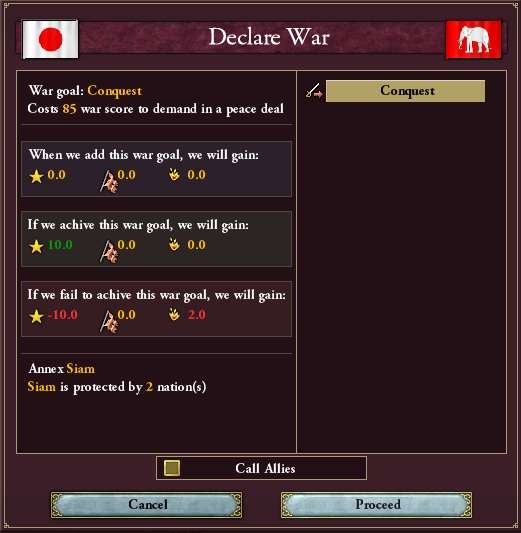
---------------------------------------------------------------------------------------------------------------------
That concludes the update; our next one will detail our glorious (?) war with Siam.

















